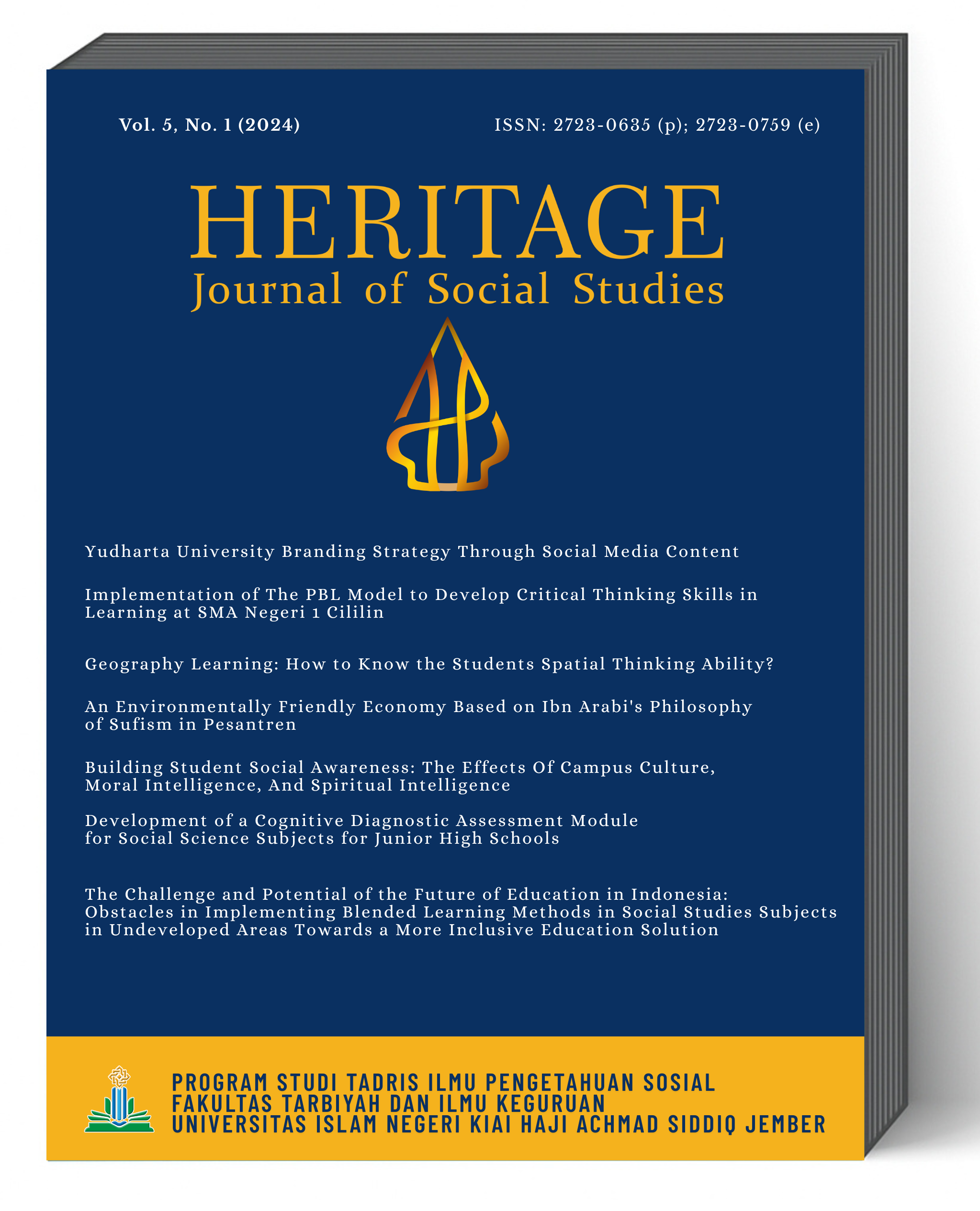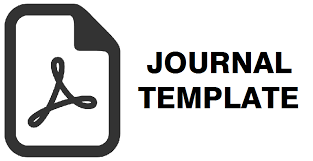Implementation of The PBL Model to Develop Critical Thinking Skills in Learning at SMA Negeri 1 Cililin
DOI:
https://doi.org/10.35719/hrtg.v5i1.135Keywords:
Model Problem Based Learning, Critical Thinking, Economic LearningAbstract
This research is motivated by the findings of problems in economics learning including: in economics learning students are passive; lack of critical thinking activity and creativity; teacher-centered learning (teacher centered); The learning model used by teachers tends to be monotonous. This research aims to determine the implementation of the model problem based learning to develop students' critical thinking skills in economics learning. The research method is a case study with a qualitative approach, data is collected through interviews, observation and documentation of the implementation of learning to develop critical thinking skills. The results of the research show that planning economic learning using models problem based learning to develop highly structured and systematic critical thinking skills. Implementation of economic learning with models problem based learning Overall, it has succeeded in creating a learning environment that supports the development of students' critical and analytical thinking skills. Assessment of economic learning with models problem based learning has been designed and implemented well, so that students' critical thinking, problem solving and collaboration skills develop optimally. Supporting factors for learning economics with models problem based learning really supports the development of students' critical thinking skills. Factors inhibiting economic learning with models problem based learning developing critical thinking skills is a very serious challenge. Efforts to overcome barriers to economic learning with models problem based learning can develop students' critical thinking skills effectively.
References
Arends, R. I. (2008). Learning to Teach Belajar untuk Mengajar (Edisi Ketujuh/Buku Dua). terj. Helly Pajitno Soetjipto & Sri Mulyantini Soetjipto ….
Arends, R. I. (2012). Learning to Teach Ninth Edition (9th ed.). In New Britain, USA?: Library of Congress Cataloging.
Bloom, B. (2001). APPENDIX Revised Bloom ’ s Taxonomy. ReVision.
Borko, H., & Putnam, R. T. (2013). Learning to teach. In Handbook of Educational Psychology. https://doi.org/10.4324/9780203053874-29
Brookhart, S. M. (2010). How to Assess Higher-Order Thinking Skills in Your Classroom. In Ascd.
Burke, J., Ditchfield, C., Flynn, M. A., Sneddon, S., & Stapleton, G. (2020). Lessons learned from problem-based learning. In Clinical Teacher (Vol. 17, Issue 6). https://doi.org/10.1111/tct.13147
Chappuis, S., & Stiggins, R. J. (2002). Classroom Assessment for Learning Student-Involved Assessment. Review of Educational Research, 60(1).
Dewey. (2020). Pemikiran Kritis John Dewey Tentang Pendidikan (Dalam Perspektif Kajian Filosofis). Tarbiyah Islamiyah: Jurnal Ilmiah Pendidikan Agama Islam, 10(1).
Dweck, C. (2015). Mindset: the new psychology of success. CEUR Workshop Proceedings, 1542.
Ennis, R. H. (1989). A taxonomy of critical thinking disposition and abilities. In Teaching thinking skills: Theory and practice.
Ertmer, P. A., & Ottenbreit-Leftwich, A. T. (2010). Teacher technology change: How knowledge, confidence, beliefs, and culture intersect. Journal of Research on Technology in Education, 42(3). https://doi.org/10.1080/15391523.2010.10782551
Facione, P. A. (1990). Critical Thinking?: A Statement of Expert Consensus for Purposes of Educational Assessment and Instruction Executive Summary “ The Delphi Report. The California Academic Press, 423(c).
Glaser, E. M. (1942). An Experiment in Development of Critical Thinking. Teachers College Record: The Voice of Scholarship in Education, 43(5). https://doi.org/10.1177/016146814204300507
Halpern, D. F. (1998). Teaching critical thinking for transfer across domains. American Psychologist, 53(4). https://doi.org/10.1037//0003-066x.53.4.449
Heer, R. (2012). A model of learning objectives -based on A Taxonomy for Learning, Teaching, and Assessing: A revision of Bloom’s Taxonomy of Educational Objectives. Contemporary Theories of Learning, Iowa State University.
Hess, E. D. (2015). Critical Thinking Tools. In Learn or Die. https://doi.org/10.7312/columbia/9780231170246.003.0007
Hmelo-Silver, C. E. (2004). Problem-based learning: What and how do students learn? Educational Psychology Review, 16(3), 235–266. https://doi.org/10.1023/B:EDPR.0000034022.16470.F3
Hosnan, M. (2014). Pendekatan Saintifik dan Kontekstual dalam Pembelajaran Abad 21.: Kunci Sukses Implementasi Kurikulum 2013. In Prosiding TEP & PDs Transformasi Pendidikan Abad 21.
Indira, T., Somakim, S., & Susanty, E. (2018). KEMAMPUAN BERPIKIR KRITIS SISWA SMP MELALUI PENDEKATAN PENDIDIKAN MATEMATIKA REALISTIK INDONESIA. HISTOGRAM: Jurnal Pendidikan Matematika, 1(2). https://doi.org/10.31100/histogram.v1i2.25
Jonassen, D. H. (2010). Learning to solve problems: A handbook for designing problem-solving learning environments. In Learning to Solve Problems: A Handbook for Designing Problem-Solving Learning Environments (Vol. 9780203847527). https://doi.org/10.4324/9780203847527
King, P. M., & Kitchener, K. S. (1994). Developing reflective judgment. In The Jossey-Bass social and behavioral science series.
Mamuasi, R., & Tuara, N. A. (2021). Pembelajaran Berbasis Portofolio Dalam Pendidikan IPS. Jurnal Pendidikan Dan Ekonomi …, 3(1).
Nadlir, M. (2016). PERENCANAAN PEMBELAJARAN BERBASIS KARAKTER. Jurnal Pendidikan Agama Islam (Journal of Islamic Education Studies), 1(2). https://doi.org/10.15642/pai.2013.1.2.338-352
Sanjaya, W., & Sanjaya, W. (2008). Strategi pembelajaran berorientasi standar proses pendidikan / Wina Sanjaya. In 1. MODEL PEMBELAJARAN
2. BELAJAR DAN MENGAJAR,Strategi pembelajaran berorientasi standar proses pendidikan / Wina Sanjaya (Vol. 2008, Issue 2008).
Savery, J. R. (2006). Overview of Problem-based Learning?: Definitions and Distinctions Origins of PBL. Learning, 1(1).
Schraw, G., Crippen, K. J., & Hartley, K. (2006). Promoting self-regulation in science education: Metacognition as part of a broader perspective on learning. Research in Science Education, 36(1–2), 111–139. https://doi.org/10.1007/S11165-005-3917-8/METRICS
Seng, T. O. (2004). Problem-Based Learning: the Future Frontiers. Problem-Based Learning: The Future Frontiers.
Sugiyono. (2023). Metode Penelitian Kualitatif (Untuk penelitian yang bersifat: eksploratif, enterpretif, interaktif dan konstruktif). CV. Alfabeta.
Swartz, R. J., & Perkins, D. N. (2016). Teaching thinking: Issues and approaches. Teaching Thinking: Issues and Approaches, 1–265. https://doi.org/10.4324/9781315626468/TEACHING-THINKING-ROBERT-SWARTZ-PERKINS
Tibahary, A. R., & Muliana, M. (2018). MODEL-MODEL PEMBELAJARAN INOVATIF. Scolae: Journal of Pedagogy, 1(1). https://doi.org/10.56488/scolae.v1i1.12
Triandis, H. C. (1980). Reflections on Trends in Cross-Cultural Research. Journal of Cross-Cultural Psychology, 11(1). https://doi.org/10.1177/0022022180111003
Wiggins, G., & Tighe, M. (2005). Review of: Understanding by design (2nd ed.). Colombian Applied Linguistics Journal, 19(1).
Yazidi, R. EL. (2023). Strategies for Promoting Critical Thinking in the Classroom. International Journal of English Literature and Social Sciences, 8(2). https://doi.org/10.22161/ijels.82.5
Yin, R. K. (2003). Case Study Research . Design and Methods. In SAGE Publications (Vol. 26, Issue 1). https://doi.org/10.1097/FCH.0b013e31822dda9e
Zimmerman, B. J., & Zimmerman, B. J. (2010). Becoming a Self-Regulated Learner?: An Overview Becoming a Self-Regulated Learner?: An Overview. Theory Into Practice, 5841(2002).
Downloads
Published
How to Cite
Issue
Section
License
Copyright (c) 2025 heritage

This work is licensed under a Creative Commons Attribution-ShareAlike 4.0 International License.





